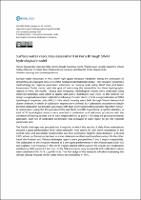Mostrar el registro sencillo del ítem
Surface water resources assessment in Peru through SWAT hydrological model
| dc.contributor.author | Asurza Véliz, Flavio Alexander | |
| dc.contributor.author | Traverso-Yucra, Kevin Arnold | |
| dc.contributor.author | Lavado-Casimiro, W. | |
| dc.contributor.author | Felipe-Obando, Oscar | |
| dc.contributor.author | Montesinos Cáceres, Cristian Albert | |
| dc.contributor.author | Llauca, Harold | |
| dc.date.accessioned | 2021-06-30T15:26:17Z | |
| dc.date.available | 2021-06-30T15:26:17Z | |
| dc.date.issued | 2020 | |
| dc.identifier.citation | Asurza Véliz, F. A., Traverso-Yucra, K. A., Lavado-Casimiro, W. S., Felipe-Obando, O., Montesinos-Cáceres, C. A., and Llauca-Soto, H. O. (2020). Surface water resources assessment in Peru through SWAT hydrological model, EGU General Assembly 2020, Online, 4–8 May 2020, EGU2020-6308, https://doi.org/10.5194/egusphere-egu2020-6308 | es_PE |
| dc.identifier.uri | https://hdl.handle.net/20.500.12542/1017 | |
| dc.description.abstract | Surface water resources in Peru show high spatio-temporal variability, being the prediction of streamflow at ungauged sites, one of the fundamental challenges today. This research presents a methodology for regional parameter estimation at national scale using SWAT (Soil and Water Assessment Tools) model, with the goal of estimating the streamflow for three hydrographic regions in Peru: the Pacific, Titicaca and Amazonas. Hydrological models were calibrated using observed discharge data which is sparse and poorly distributed over Peru. In this context, we design a regional parameter estimation following the next steps: i) First, a regionalization of 3394 hydrological response units (HRU) in the whole country were built through Ward’s hierarchical cluster criterion, in which 14 calibration regions were defined. ii) A calibration procedure to obtain the best calibration parameters was made with Non-dominated Sorting Genetic Algorithm (NSGA-II) optimization using the Kling-Gupta (KGE) and Nash Sutcliffe Logarithmic (LogNSE) statistics. A total of 31 hydrological stations were selected to calibration and validation procedure with the condition of leaving at least one in each region defined at point i) iii) Using the physical similarity approach, each set of calibrated parameters was averaged in each region to get the regional parameter sets. | es_PE |
| dc.format | application/pdf | es_PE |
| dc.language.iso | eng | es_PE |
| dc.publisher | European Geosciences Union | es_PE |
| dc.relation.uri | https://meetingorganizer.copernicus.org/EGU2020/EGU2020-6308.html | es_PE |
| dc.rights | info:eu-repo/semantics/openAccess | es_PE |
| dc.rights | Reconocimiento - No comercial - Sin obra derivada (CC BY-NC-ND) | es_PE |
| dc.rights.uri | https://creativecommons.org/licenses/by-nc-nd/4.0/ | es_PE |
| dc.source | Repositorio Institucional - SENAMHI | es_PE |
| dc.source | Servicio Nacional de Meteorología e Hidrología del Perú | es_PE |
| dc.subject | Hydrological Model | es_PE |
| dc.subject | Modelos y Simulación | es_PE |
| dc.subject | SWAT Model | es_PE |
| dc.subject | Caudal | es_PE |
| dc.subject | Cuenca Hidrográfica | es_PE |
| dc.subject | Cuencas | es_PE |
| dc.title | Surface water resources assessment in Peru through SWAT hydrological model | es_PE |
| dc.type | info:eu-repo/semantics/conferenceObject | es_PE |
| dc.identifier.doi | https://doi.org/10.5194/egusphere-egu2020-6308 | |
| dc.subject.ocde | https://purl.org/pe-repo/ocde/ford#1.05.11 | es_PE |
| dc.subject.sinia | gestion de recursos hidricos de cuenca - Agua | es_PE |
| dc.type.sinia | text/libro.presentacion | es_PE |
| dc.identifier.url | https://hdl.handle.net/20.500.12542/1017 | |
| dc.identifier.url | https://hdl.handle.net/20.500.12542/1017 |
Ficheros en el ítem
Este ítem aparece en la(s) siguiente(s) colección(es)
-
Congreso [33]









